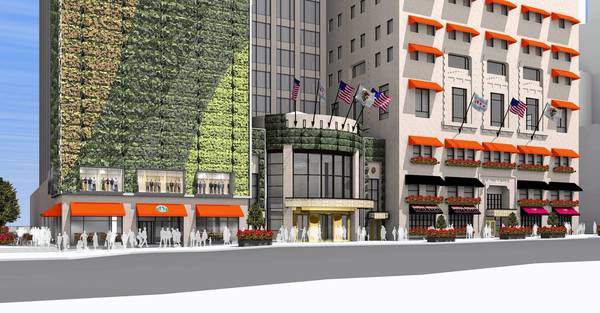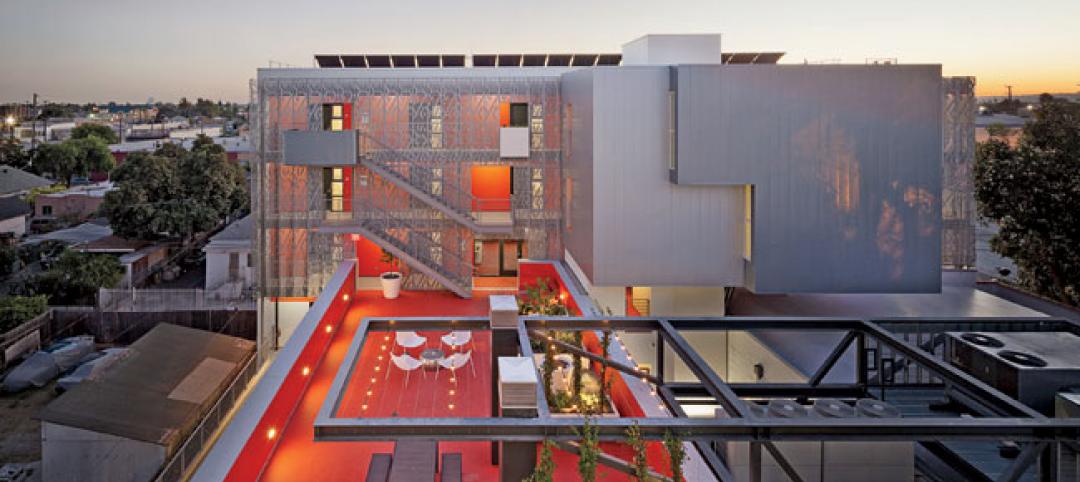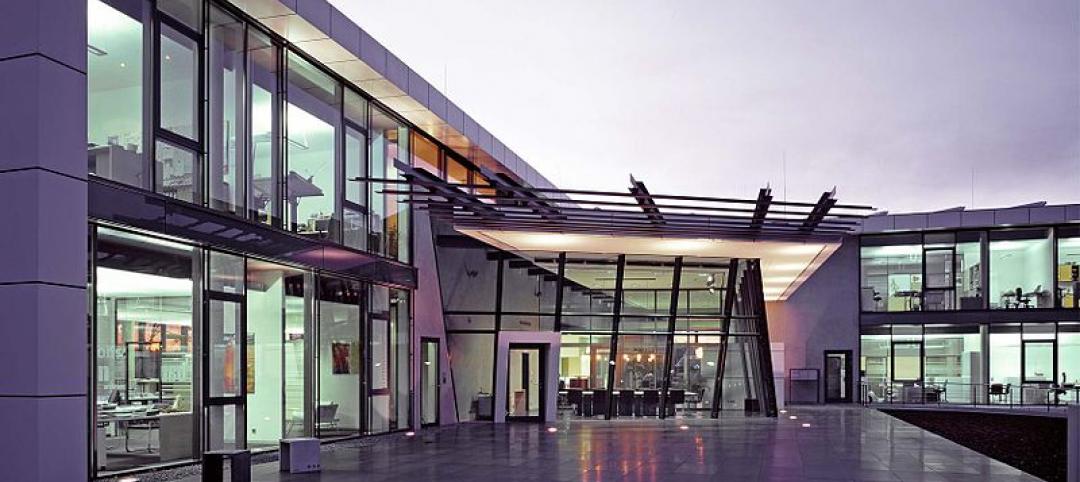Laurence Geller, the blunt-talking British chief executive of Strategic Hotels & Resorts, plans to literally spruce up the facade of the InterContinental Chicago hotel on North Michigan Avenue with a 9,800-sf living green wall.
The wall, which requires City Council approval, would be covered in thousands of plants growing year-round in concealed trays hung perpendicular to the wall. It would be the largest wall of its kind in North America and one of a handful in Chicago, according to Geller and Anne Roberts, the local landscape designer he has hired to build it.
"Unless you start glamoring this thing up, it will never look iconic," Geller said of the two-tower hotel, which Chicago-based Strategic owns. The green wall "will make this North Tower disappear."
Why, I asked, was that tower built with so few windows?
"Because it was built stupidly — cheaply and stupidly some 30-odd-years ago," Geller said. "I don't know what was in anyone's head."
Ald. Brendan Reilly, whose ward includes North Michigan Avenue, said he would introduce an ordinance authorizing the wall and other improvements to the hotel's exterior — awnings, a larger patio to the north, additional lighting — as early as July. The wall will wrap around about 10 of the North Tower's 26 stories and will be lit at night.
"I can't image this will be considered controversial," Reilly said. "Otherwise, it is a pretty unattractive blank wall."
If the council approves the project, Geller expects the frame will be finished this winter and the plants hung by spring. He estimates all of the improvements will cost $2 million to $3 million and hopes the wall will draw more customers.
"We're going to do it because it's right, and we may make a lot of money," he said. "All I need is a quarter-point (more) of market share to get a 20 percent return. And if I don't get it, I don't get it, but at least I'll have made the building better."
Chicago is known for its green roofs but has few green walls, a trend that began in the late 1980s in France. Like green roofs, living walls scrub the air and provide insulation, thereby lowering electricity costs.
But Geller said his water bill likely will increase. Roberts is going to try to water the wall with rain collected on the InterContinental's roof, but she admitted it would not meet all of the garden's needs.
The scarcity of green walls here, experts say, is due to cost and climate. The new Rivers Casino in Des Plaines has a small indoor one, and the Chicago Botanic Garden's new children's garden has four outdoor walls that cover about 670 square feet total.
The far larger project Geller envisions was once thought impossible in Chicago.
"At one time, way back at the beginning of Millennium Park, we considered a Jeff Koons-style puppy made of plants," said Donna La Pietra, the head of Millennium Park Inc., the park's fundraising arm. "The first question we had was, 'Are you sure?' The next was, 'What's going to happen in the winter?' That has always been the thorny question. What kinds of materials can one use? But for almost every challenge that gets raised in the Midwest about plant materials, someone finds a solution. Now we have much more tolerant plants."
Roberts, who has never constructed a green wall, has yet to finalize the hybrids she will use but said evergreens and native plants will be part of the mix. She is working with Rochester, N.Y.-based Green Living Technologies International, which has experience and built the walls at the botanic garden.
Before hanging the plants, Roberts will grow them indoors and slowly rotate them over several months to a 90-degree angle.
"They have to be oriented to that condition before they're put on the wall," she said.
Roberts and her team will control the wall's plastic irrigation system from an off-site computer. When the temperature dips below freezing, the system will be drained. Maintenance will be necessary two to three times per year and done in a similar manner to window-washing. Workers will dangle from the roof to trim and replace plants.
"This is horticulture to the 100th degree," Roberts said. "It's infinitely much harder to figure out what's going to grow on a wall. And this wall will face west, meaning very, very hot in the summer, and is near the lake, meaning high winds."
Geller said the first year will be "trial and error and effort" — "we'll over-irrigate and kill some (plants)," he warned. But if it succeeds, he believes tourists will flock to photograph it and that will propel more business.
"I think Michigan Avenue is old-fashioned in the way its retailing is," said Geller, who praised only the Crate & Barrel store and a Burberry store that is under construction. "Unless architecture meets retailing, retailing will never be successful."
A bolder Michigan Avenue would attract more tourists, and, he added, "I'd make more money." +
Related Stories
| Jan 12, 2015
23 projects win AIA's highest architecture award
Bjarke Ingels' Danish Maritime Museum and William Rawn's Cambridge Public Library are among the winning projects.
| Jan 9, 2015
Santiago Calatrava talks with BBC about St. Nicholas Church on Ground Zero
Calatrava reveals that he wanted to retain the “tiny home” feel of the original church building that was destroyed with the twin towers on 9/11.
| Jan 9, 2015
Nonresidential construction hiring surges in December 2014
The U.S. construction industry added 48,000 jobs in December, including 22,800 jobs in nonresidential construction, according to the Bureau of Labor Statistics preliminary estimate released Jan. 9.
| Jan 9, 2015
10 surprising lessons Perkins+Will has learned about workplace projects
P+W's Janice Barnes shares some of most unexpected lessons from her firm's work on office design projects, including the importance of post-occupancy evaluations and having a cohesive transition strategy for workers.
| Jan 9, 2015
Technology and media tenants, not financial companies, fill up One World Trade Center
The financial sector has almost no presence in the new tower, with creative and media companies, such as magazine publisher Conde Nast, dominating the vast majority of leased space.
| Jan 8, 2015
Microsoft shutters classic clipart gallery: Reaction from a graphic designer
Microsoft shut down its tried-and-true clipart gallery, ridding the world not only of a trope of graphic design, but a nostalgic piece of digital design history, writes HDR's Dylan Coonrad.
| Jan 8, 2015
The future of alternative work spaces: open-access markets, co-working, and in-between spaces
During the past five years, people have begun to actively seek out third places not just to get a day’s work done, but to develop businesses of a new kind and establish themselves as part of a real-time conversation of diverse entrepreneurs, writes Gensler's Shawn Gehle.
Smart Buildings | Jan 7, 2015
NIBS report: Small commercial buildings offer huge energy efficiency retrofit opportunities
The report identifies several barriers to investment in such retrofits, such as the costs and complexity associated with relatively small loan sizes, and issues many small-building owners have in understanding and trusting predicted retrofit outcomes.
| Jan 7, 2015
University of Chicago releases proposed sites for Obama library bid
There are two proposed sites for the plan, both owned by the Chicago Park District in Chicago’s South Side, near the university’s campus in Hyde Park, according to the Chicago Sun-Times.
| Jan 7, 2015
4 audacious projects that could transform Houston
Converting the Astrodome to an urban farm and public park is one of the proposals on the table in Houston, according to news site Houston CultureMap.
















